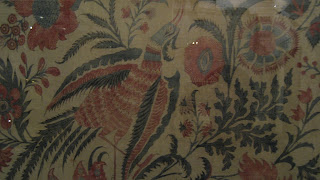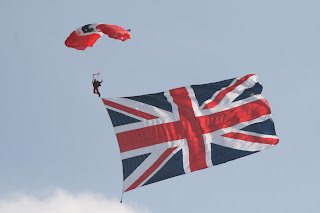New Year is for me always a time to take stock of the year just past. Every time I visit an exhibition now I make a record of it in a scrapbook - I have been doing it since 2012 and it is surprising how just a little bit of information takes you back in time, remembering things that were on display. Something nice to look through on a cold, dark, rainy winter's evening.
However New Year is also a time for looking forward and planning exhibitions coming up over the year ahead, though I doubt I'll get to them all. This is a list of textile related exhibitions either currently in progress (and some of which I have seen, but recommend) or coming up in the next 12 months.
Firstly some shows already started, some just about to finish:
Until 4th January 2016 - Fashion Rules at Kensington Palace, London - looking at the glamorous dresses of the Queen, Princess Margaret and Princess Diana; it then reopens on 11 February 2016 as Fashion Rules, Restyled.
Until 9 January 2016 - Losing the Compass at White Cube, Mason's Yard in Bermondsey - includes work by Amish quilters, William Morris but also many fine art, contemporary artists working in textiles.
Until 10 January 2016 - Fabric of India at the Victoria and Albert Museum, London. Definitely a "must see" exhibition which I hoped to revisit; but now think time is against me.
Until 13 January 2016 - Olga de Amariai: Alchemist at the Rook & Raven Gallery on London's Soho area. Another exhibition I have only just learnt of, with work by an artist described in Embroidery magazine (Jan/Feb 2016) as "the Louise Bourgeois of Columbia" (review by Liz Hoggard".
Until 13 January 2016 - Olga de Amariai: Alchemist at the Rook & Raven Gallery on London's Soho area. Another exhibition I have only just learnt of, with work by an artist described in Embroidery magazine (Jan/Feb 2016) as "the Louise Bourgeois of Columbia" (review by Liz Hoggard".
Until 31 January 2016 - Shoes: Pleasure and Pain also at the Victoria and Albert Museum, London. An interesting exhibition but very crowded - in the lower galleries. Wish I had had time to leave my coat in the cloakroom.
Until 28 February 2016 - Liberty in Fashion at the Fashion and Textile Museum, London. Still on my "to do" list.
Until 1 March 2016 - The White Show at the Flow Gallery, London includes stitched work by Richard McVetis. Another "to do" list show.
Until 1 May 2016 - A Stitch in Time: Home Sewing Before 1900, also at the Victoria and Albert Museum, London. I have only just learnt about this display which apparently has been available since May 2015. It is in Gallery 116.
Until 15 May 2016 - Life and Sole: Footwear from the Islamic World - another display I have only just discovered and apparently includes some embroidered shoes. In Room 34 of the British Museum.
Opening in 2016:
5 January to 19 March 2016 - Centenary Stitches will be exhibiting at the National Archives, Kew. Knitted clothing items made for a film Tell Them About Us, that told the story of two brothers during WWI also gave an insight into the sort of items made on the Home Front to make life in the trenches a little more bearable.
11 February to 22 May 2016 - Vogue 100: A Century of Style, National Portrait Gallery, London. An exhibition to celebrate 100 years of British Vogue with a display of photographs documenting the story of one of the most influential fashion magazines.
20 February to 29 May 2016 - Social Fabric: African Textiles at the William Morris Gallery, Walthamstow. Printed fabrics from east and south Africa show how textiles can express the concerns of the people who wear them.
11 March to 17 April 2016 - Art Textiles: Marian Clayden at the Fashion and Textile Museum, London. Born in 1937, Marian was a skilled dyer and painter of textiles for the fashion industry. She died in 2015 and this retrospective will showcase work from her incredible career.
16 April 2016 to 5 February 2017 - Undressed: 350 Years of Underwear in Fashion at the Victoria and Albert Museum. A look at the history of undergarments.
15 June to 10 July 2016 - E.A.S.T. will be exhibiting Between the Lines at Landmark Arts Centre, Teddington. Also talk and workshops - more details in due course.
15 June to 10 July 2016 - E.A.S.T. will be exhibiting Between the Lines at Landmark Arts Centre, Teddington. Also talk and workshops - more details in due course.
13 October 2016 to 5 February 2017 - The Vulgar at the Barbican, London. Looking at notions of vulgarity by looking at fashions of the Renaissance, 18th century and current times.
21 November 2016 to 28 March 2017 - Opus Anglicanum: Masterpieces of English Medieval Embroidery at the Victoria and Albert Museum. A golden age for English embroidery, this exhibition looks at not only the craftsmanship but at the wider world at the time they were created.
I will try and keep a separate page on this blog now of exhibitions with a textile theme. Hopefully I can update this as and when I learn of new ones.
I'd love to hear from anyone else on exhibitions I should add.
I'd love to hear from anyone else on exhibitions I should add.

















































